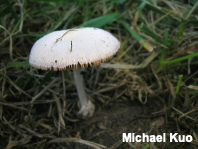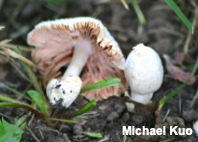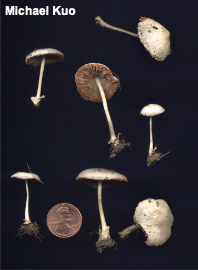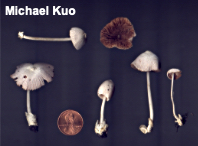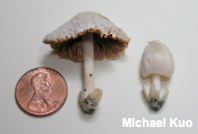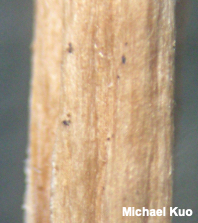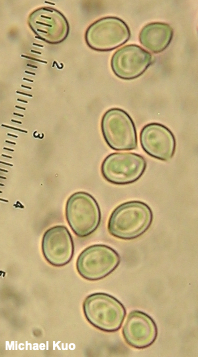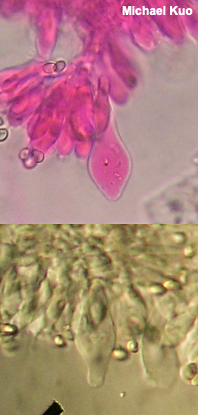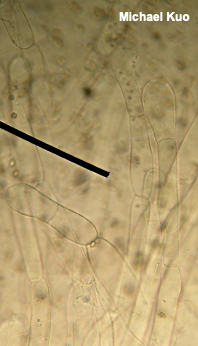| Major Groups > Gilled Mushrooms > Pink-Spored > Volvariella and Volvopluteus > Volvariella pusilla |

|
Volvariella pusilla [ Basidiomycota > Agaricales > Pluteaceae > Volvariella . . . ] by Michael Kuo This is one of several tiny, whitish Volvariella species that are quite similar—but it can be distinguished by its smooth stem and its lined cap margin. The closest commonly found look-alike, Volvariella hypopithys, has a densely but finely hairy stem, and a non-lined margin, while other known look-alikes have caps that are not completely white. Volvariella pusilla is listed in many sources as growing in gardens, lawns, and other cultivated habitats, and I suspect that it is partial to the disturbed ground of these settings (like some morels, including Morchella rufobrunnea). In my experience Volvariella pusilla does, indeed, appear in lawns, including my own, and it often creates a fantastic excuse to stop mowing in the middle of the job, in order to admire the little mushrooms, photograph them, collect them, talk to them (my neighbors are used to this kind of behavior) . . . anything but start mowing again. Description: Ecology: Apparently saprobic; growing alone or gregariously; usually reported from gardens, lawns, wood chips, and so on—but found in woods as well, at least in areas of disturbed ground like pathsides; spring through fall; distributed primarily east of the Rocky Mountains, although it is occasionally reported from western North America. The illustrated and described collections are from Illinois. Cap: 1–3 cm across; egg-shaped at first, becoming convex to broadly convex, broadly bell-shaped, or nearly flat; dry; finely silky; whitish; becoming finely lined from the margin about halfway to the center. Gills: Free from the stem; close or crowded; whitish becoming pink to brownish pink. Stem: 2–5 cm long; 2–3 mm thick; more or less equal; dry; bald or with a few fibrils, but not hairy or fuzzy; white; without a ring; the base encased in a thick, white to grayish, sack-like, flaring volva which may be buried. Flesh: Thin; white; not changing when sliced. Odor and Taste: Not distinctive. Chemical Reactions: KOH negative on cap surface. Spore Print: Brownish pink. Microscopic Features: Spores 5–7.5 x 4–5 µm; more or less ellipsoid; thick-walled; smooth; hyaline to yellowish in KOH. Basidia 4-sterigmate. Cheilocystidia and pleurocystidia to 50 x 17.5 µm; lageniform to widely lageniform or obpyriform; smooth; thin-walled; hyaline in KOH. Pileipellis a trichoderm of very long, cylindric elements 7.5–25 µm wide, smooth, hyaline in KOH, septate; terminal cells cylindric with rounded apices, or clavate and swollen up to 40 µm wide. Clamp connections not found. REFERENCES: (Persoon, 1799) Singer, 1951. (Fries, 1821; Kauffman, 1918; Coker, 1947; Shaffer, 1957; Smith, Smith & Weber, 1979; Arora, 1986; Monoson, Methven & Sundberg, 1993; Breitenbach & Kränzlin, 1995; Miller & Miller, 2006; Justo, 2010; Justo et al., 2011b.) Herb. Kuo 08010201, 08240503, 06201401. This site contains no information about the edibility or toxicity of mushrooms. |
© MushroomExpert.Com |
|
Cite this page as: Kuo, M. (2018, November). Volvariella pusilla. Retrieved from the MushroomExpert.Com Web site: http://www.mushroomexpert.com/volvariella_pusilla.html |
